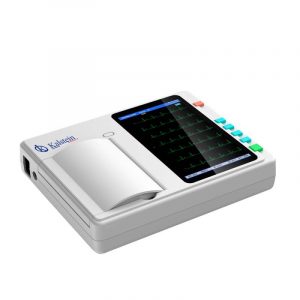As technology and medical science advance, healthcare professionals have more tools at their disposal to assist them in the detection and treatment of complex diseases. One of these essential tools is the electrocardiograph, a fundamental diagnostic device in modern cardiology. This article will examine: the role of the electrocardiograph, how it aids in the diagnosis of heart disease, and its importance in the treatment plan.
The Role of the Electrocardiograph
An electrocardiograph is a medical instrument that records the electrical activity of the heart. Physicians use this electrical activity to measure and evaluate the overall functioning of the heart. Specifically, this tool can detect if there is an irregular heart rhythm, if the walls of the heart are too thick, or if the heart is working too hard, among other problems.
Performing an electrocardiogram (ECG) is a quick, painless and noninvasive procedure. The electrocardiography device records the electrical activity of the heart on a graph that is then interpreted by a physician. This interpretation allows the physician to determine if there are any cardiac abnormalities that require medical attention.
The Electrocardiograph in the Diagnosis of Heart Disease
The role of the electrocardiogram in the diagnosis of heart disease cannot be underestimated. For starters, an ECG can reveal a number of cardiac conditions, including coronary artery disease, arrhythmia, and even a heart attack. In addition, this tool is valuable in detecting pre-existing conditions or changes in the heart that may indicate advancing disease.
One of the main benefits of the ECG is that it gives physicians a real-time snapshot of the heart’s activity. This means it can be used to diagnose acute heart conditions, such as a heart attack, even while the patient is experiencing symptoms.
The Importance of the Electrocardiograph in the Treatment of Heart Disease
Beyond its role in diagnosis, the electrocardiogram also plays an important role in guiding the patient’s treatment plan. Regular monitoring of ECGs can help physicians determine the effectiveness of certain treatments, such as medications or surgical procedures, and whether the treatment plan needs to be modified.
In addition, in emergency situations, rapid interpretation of an ECG can be the line that separates life from death, allowing emergency responders to understand the severity of the cardiac situation and to intervene appropriately and in a timely manner.
Kalstein Solutions
In summary, the electrocardiograph is a fundamental tool for diagnosing and treating heart disease. It contributes crucially in accurately determining cardiac conditions and formulating effective treatment plans. As medical technologies advance, this tool is likely to become even more essential in the fight against heart disease.
We at Kalstein have YR models that perfectly meet the needs of efficiency and effectiveness of medical areas, know our equipment HERE, we assure you not only a quality equipment but the best price in the market, and we guarantee a safe purchase, where the technical team and other advisors will answer your questions.

